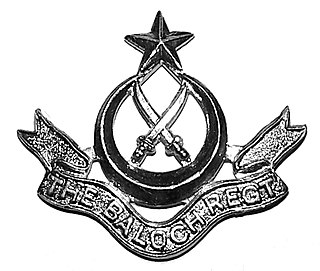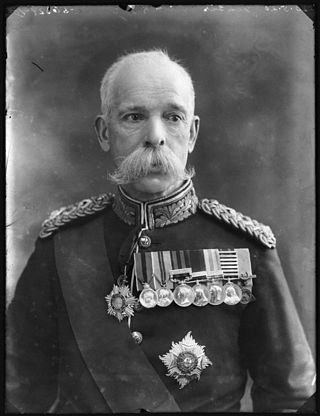
Bernard Arthur William Patrick Hastings Forbes, 8th Earl of Granard,, styled Viscount Forbes from 1874 to 1889, was an Anglo-Irish soldier and Liberal politician.
Lieutenant-Colonel Ernest Fitzroy Morrison-Bell, was a British soldier and parliamentarian.
Brigadier Ronald Gervase Mountain was an officer in the British Indian Army during World War I and World War II.

The Baloch Regiment is an infantry regiment of the Pakistan Army. The modern regiment was formed in May 1956 by the merger of 8th Punjab and Bahawalpur Regiments with the Baluch Regiment. Since then, further raisings have brought the strength of the Regiment to 27 battalions. The Baloch Regiment is descended from the infantry of the old British Indian Army and is named after Balochistan. Before 1991, it was called the Baluch Regiment but the spelling was changed to 'Baloch' to better reflect the correct pronunciation.
Geoffrey Cecil Twisleton-Wykeham-Fiennes, 18th Baron Saye and Sele was an English soldier and Liberal politician from the Twisleton-Wykeham-Fiennes family. He served as Comptroller of the Household between 1912 and 1915.

The 129th Duke of Connaught's Own Baluchis was an infantry regiment of the British Indian Army raised in 1846 as the 2nd Bellochee Battalion. It was designated as the 129th Duke of Connaught's Own Baluchis in 1903, and became 4th Battalion 10th Baluch Regiment in 1922. In 1947, it was allocated to Pakistan Army, where it continues to exist as 11th Battalion of The Baloch Regiment.

General Sir Torquhil George Matheson, 5th Baronet, was a Scottish officer who commanded three different divisions of the British Army in some of the heaviest fighting of the First World War. He had previously served in the militia and with the Coldstream Guards in the Second Boer War. For his service, he was knighted in 1921 and in 1944 he inherited the Matheson baronetcy from his brother Roderick.
Lieutenant Colonel Lord Herbert Andrew Montagu Douglas Scott, was the fifth child born to William Henry Walter Montagu Douglas Scott, 6th Duke of Buccleuch & 8th Duke of Queensberry and Louisa Montagu Douglas Scott, Duchess of Buccleuch and Queensberry.

The 10th Baluch or Baluch Regiment was a regiment of the British Indian Army from 1922 to 1947. After independence, it was transferred to the Pakistan Army. In 1956, it was amalgamated with the 8th Punjab and Bahawalpur Regiments. During more than a hundred years of military service, the 10th Baluch Regiment acquired a distinguished record amongst the regiments of the British Indian Army. Its list of honours and awards includes four Victoria Crosses.
The 126th Baluchistan Infantry was an infantry regiment of the British Indian Army raised in 1825 as the 2nd Extra Battalion of Bombay Native Infantry. It was designated as the 126th Baluchistan Infantry in 1903 and became 2nd Battalion 10th Baluch Regiment in 1922. In 1947, it was allocated to the Pakistan Army, where it continues to exist as 7th Battalion of The Baloch Regiment.

The 124th Duchess of Connaught's Own Baluchistan Infantry was an infantry regiment of the British Indian Army raised in 1820 as the 2nd (Marine) Battalion 12th Regiment of Bombay Native Infantry. It was designated as the 124th Duchess of Connaught's Own Baluchistan Infantry in 1903 and became 1st Battalion 10th Baluch Regiment in 1922. In 1947, it was allocated to Pakistan Army, where it continues to exist as 6th Battalion of The Baloch Regiment.
The 127th Queen Mary's Own Baluch Light Infantry was an infantry regiment of the British Indian Army raised in 1844 as The Scinde Bellochee Corps. It was designated as the 127th Baluch Light Infantry in 1903 and became 3rd Battalion 10th Baluch Regiment in 1922. In 1947, it was allocated to the Pakistan Army, where it continues to exist as the 10th Battalion of The Baloch Regiment.

General Sir Laurence James Oliphant,, 9th of Condie and 31st Chief of Clan Oliphant was a British Army general who reached high office in the early years of the twentieth century.
Major-General Sir Frederick Spencer Wilson Robb, was a senior British Army officer who went on to be Military Secretary.

Lieutenant General Sir William Edmund Franklyn, was a senior British Army officer who served as Military Secretary from 1911 to 1914.

General Sir Arthur Singleton Wynne,, was a senior British Army officer from the Anglo-Irish gentry who served as Military Secretary.
British East Africa 1896 is a Battle Honour awarded to the 24th (Baluchistan) Regiment of Bombay Infantry; an infantry battalion of the British Indian Army, which participated in the 1896 expedition to British East Africa to suppress a local rebellion.
Lieutenant General Marcus John Slade was a British Army officer who became Lieutenant Governor of Guernsey.
General Sir Walter Stewart Leslie KCB, KBE, CMG, DSO was a Scottish officer who served in the British Indian Army.
Brigadier Henry Coventry Maitland-Makgill-Crichton, was a Scottish senior officer in the British Army. A graduate of the Royal Military College, Sandhurst, Maitland served as an officer in the Royal Scots Fusiliers during the Second Boer War and the First World War. He was severely wounded in both conflicts and received multiple mentions in despatches.










